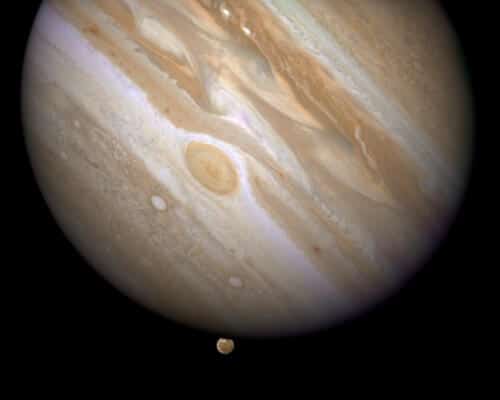This means that the core was much larger in the past and may disappear completely at some point in the future. Will justice be completely destroyed in such a case, the answer is probably no.

Jupiter, the largest and heaviest planet in our solar system has become its own worst enemy. It slowly turns the core in its center from solid to liquid, thus causing it to self-destruct and disappear over time. This means that the core was much larger in the past and may disappear completely at some point in the future. Will justice be completely destroyed in such a case, the answer is probably no.
Jupiter's core is composed of iron, rocks and ice and weighs almost 10 times that of the entire Earth. But it is still small relative to the mass of Jupiter itself, which is 318 times that of Earth. The core is buried under a thick atmosphere composed of hydrogen and helium. The conditions here are difficult, and the temperature reaches about 16 degrees Kelvin - hotter than on the surface of the sun and air pressure with a strength of 40 million atmospheres (one atmosphere is the air pressure around the Earth's coastal plains).
The core is surrounded by metallic liquid hydrogen created as a result of the enormous pressure at the bottom of the atmosphere. Most of the volume of the star is the atmosphere itself, this is the reason why Jupiter (and Saturn Uron and Rahab are also called gas stars).
One of the main components in the core is the rock made of magnesium oxides. Planetary scientists want to see what will happen to the rock under the conditions prevailing in its core. They found that soluble and decomposed. So if this is the case, it means that it was once much larger in the past than it is today and the scientists would like to understand the process.
According to David Stevenson of the California Institute of Technology "If we can do this, it will be a useful statement of what justice was like after it was created. Did it have a significant core, and if so, what was its mass? 5,10,15, XNUMX, XNUMX land mass?"
The findings also show that extrasolar planets that are even larger than Jupiter, and therefore also hotter in their cores, may not contain a core at all. They will be gas giants in the most literal sense.
Currently, it is impossible to recreate the conditions inside Jupiter in the laboratory, but the Juno spacecraft will provide much more data when it reaches Jupiter and begins orbiting it in 2016.

14 תגובות
The two new moons of Jupiter will be called Nachman (after Maran Rabbi of Breslav) and Yosef after Maran Ovadia N.Y.
That is, if it is true that it has water and the temperature range ranges from near absolute zero to thousands of Kelvin, certain regions of its atmosphere may support life.
Broken = Burma
You were just waiting for someone to ask, huh father? You couldn't put their normal name in brackets or something...
Although Myanmar has been broken for some 10 years, Burma is still written in parentheses... so that people will understand...
https://www.hayadan.org.il/hebrew-names-to-uranus-and-neptune-3112090/
Oron and Rahab?! Who invented these names??
Why didn't we move completely: Shabtai Zvi, Haim (Jomes) Oron and Rani Rahab...
"One's own worst enemy." "He causes it to self-destruct and disappear over time." End quote. Indeed a perfect description of our justice system where justice disappears and goes is this an astrological article or something?
It makes more sense that there is a state of equilibrium between magnesium oxide in a liquid state and the same oxide in a solid state, the scientists only discovered that under similar conditions the oxide can crumble and dissolve, but this does not point to the other side of the equation where gravity causes that dissolved oxide to combine back into a nucleus and solidify.
Saturn=Saturn Oron=Uranus and Rahab=Neptune
How is there ice in the core at such a temperature? And what kind of ice is this?
air pressure?!?!
There is no air there!!!
There is pressure, and that's it!
In the original article in Universe Today it says "hotter from the face of the sun" and not from the center of the sun. The core also became a nucleus...
right! In which section is it written that the core is hotter than the core of the sun?... It was supposed to throw the material out, right? Because it doesn't have enough mass to hold onto the material and thus maintain a kind of chain reaction of burning helium and hydrogen?... Yehuda Michael anyone?
Error in the article - the temperature at the center of the sun is about 10 million degrees Kelvin and not less than 15 thousand as claimed in the article, and of course no planet has a hotter core than the center of the sun otherwise it would have long ago produced energy in the process of fusion.